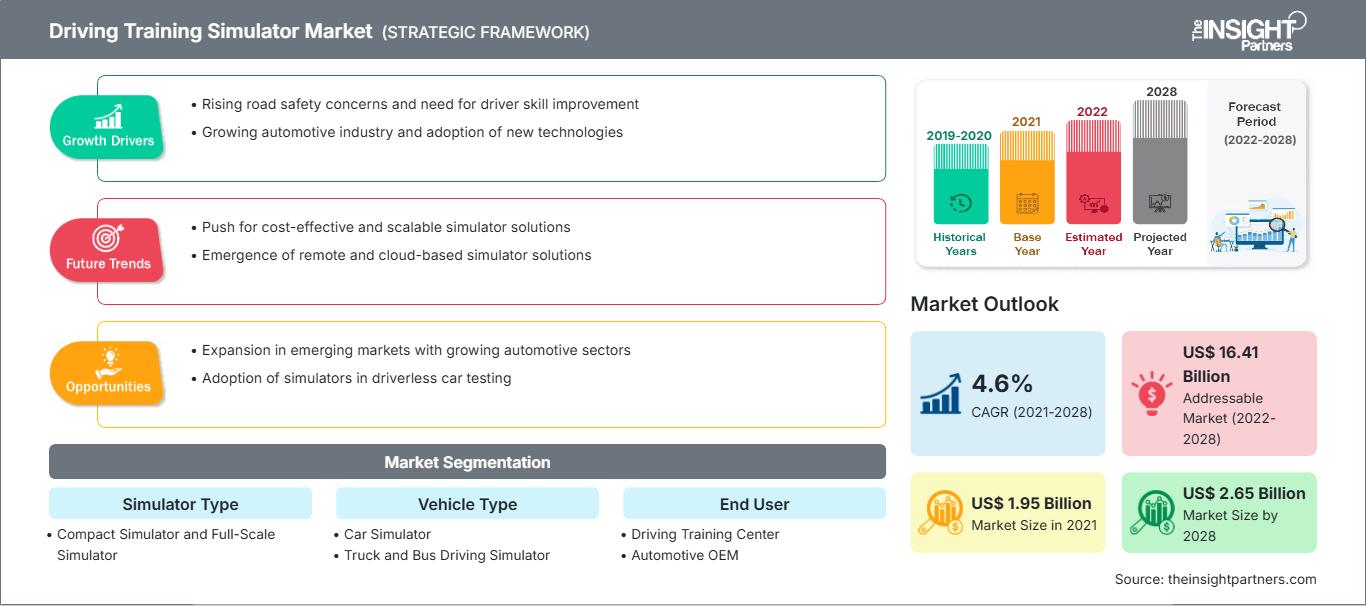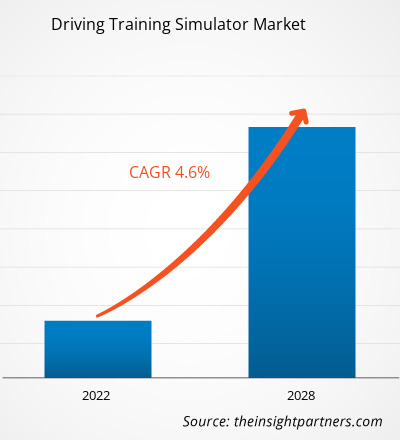2021年,全球驾驶训练模拟器市场价值为19.5亿美元;预计2022年至2028年的复合年增长率将达到4.6%。
由于交通事故和空中交通的增加、即将启动的高铁项目以及自动驾驶汽车研发投入的大量投入,对专业驾驶员的需求不断增长。这反过来又推动了发达国家和发展中国家的市场增长。全球机场和空中交通项目的扩张、警用和应急车辆模拟器的开发以及自动驾驶和半自动驾驶汽车的快速发展,预计将在预测期内推动市场增长。然而,实时控制方面的挑战、缺乏规范和标准以及集成的复杂性可能会阻碍驾驶训练模拟器市场的发展。
在车辆测试的各个阶段,驾驶训练模拟器在汽车及相关行业中越来越受欢迎。工程师和研究人员目前正在利用这项技术在虚拟环境中真实地展现车辆的整体性能,从而帮助改进车辆设计和系统性能。飞行模拟器也用于军事和航空业,用于训练飞行员驾驶民用和军用飞机。
自定义此报告以满足您的要求
您将免费获得任何报告的定制,包括本报告的部分内容,或国家级分析、Excel 数据包,以及为初创企业和大学提供超值优惠和折扣
驾驶训练模拟器市场: 战略洞察

- 获取本报告的主要市场趋势。这个免费样本将包括数据分析,从市场趋势到估计和预测。
您将免费获得任何报告的定制,包括本报告的部分内容,或国家级分析、Excel 数据包,以及为初创企业和大学提供超值优惠和折扣
驾驶训练模拟器市场: 战略洞察

- 获取本报告的主要市场趋势。这个免费样本将包括数据分析,从市场趋势到估计和预测。
自动驾驶汽车必须经过广泛的研究和在各种环境下的测试才能上路。彻底验证自动驾驶汽车所需的罕见和危险事件很难体验。NVIDIA DRIVe Sim 解决了这些问题,这是一个物理上精确的模拟平台,可以生成接近真实情况的合成数据。借助 DRIVE Sim,自动驾驶汽车 (AV) 工程师可以提高产量、效率和测试覆盖率,同时减少真实驾驶并加快上市时间。通过高保真度和物理上精确的模拟,该驾驶模拟器开发了一种经济高效、可扩展的方法,将自动驾驶汽车引入道路。它利用人工智能 (AI) 等基础技术,提供一个强大的云计算平台,可以为 AV 的创建和验证生成各种真实情况。驾驶模拟器使用精确地图数据构建实际设置的数字孪生,并可以创建数据集来测试或训练车辆的决策或感知系统。它还可以连接到软件在环 (SIL) 或硬件在环 (HIL) 配置中的 AV 堆栈,以验证整个集成系统。
全球驾驶训练模拟器市场根据模拟器类型、车辆类型、最终用户和地理位置进行细分。根据模拟器类型,全球驾驶训练模拟器市场分为紧凑型模拟器和全尺寸模拟器。就车辆类型而言,市场细分为汽车模拟器、卡车和公共汽车驾驶模拟器等。根据最终用户,市场分为驾驶训练中心、汽车原始设备制造商和其他。按地域划分,市场细分为北美、欧洲、亚太地区、中东和非洲以及南美。 2021 年,北美占据了整个市场主导地位,欧洲占据了第二大市场份额。
新冠疫情对驾驶训练模拟器市场的影响
新冠疫情严重影响了北美的汽车原始设备制造商 (OEM)、供应商和供应链。由于不确定的经济危机,消费者大宗购买意愿降低,导致新车需求下降。这同时影响了美国和加拿大的驾驶训练中心,降低了消费者需求。结果,乘用车驾驶训练模拟器市场萎缩。然而,从 2021 年开始,驾驶模拟器的需求出现了短暂的上升。参加体育赛事的驾驶员需要模拟训练和练习才能获得虚拟环境体验。此外,对虚拟仿真和安全日益增长的需求使汽车制造商能够融入先进的功能,例如紧凑型模拟器和高级驾驶辅助系统 (ADAS)。
即使在新冠疫情爆发之前,汽车原始设备制造商和供应商的财务实力就已经很薄弱。受疫情影响,主要汽车供应商的营业利润同比下降。因此,北美汽车市场下滑,导致研发投资下降,尤其是在驾驶模拟行业。此外,由于安全和封锁协议的实施,福特和通用汽车的制造工厂放缓了运营。然而,由于北美各国放松封锁措施以及出台刺激经济的财政方案,2021 年需求有所复苏。
市场洞察 –驾驶训练模拟器市场
对熟练驾驶员和驾驶安全预防措施的需求不断增加
为了应对人为失误导致的事故增多,对能够在各种情况下操作车辆的经验丰富的驾驶员的需求正在显著增加。由于驾驶训练模拟器可以借助虚拟环境教会驾驶员如何从各个角度避免碰撞,因此其需求也在增加,从而带来了市场的高速增长。技术进步和投资也使市场受益匪浅。
在世界各地,驾驶安全预防措施变得越来越重要。驾驶模拟器广泛应用于安全和负责任驾驶的指导、测试和研究。虚拟驾驶模拟器可以作为道路测试的安全替代方案,用于进行研究、测试和培训。研究人员对研究和测试应用的各个方面进行了调查,包括模拟器晕动症、疲劳和学习行为,以改善模拟驾驶情况,从而提高模拟器的有效性。
与众多机构和技术实验室合作一直是研究应用的有效策略。例如,火车模拟器非常适合教授新驾驶员驾驶基础知识。这些便携式模拟器可以通过反应评估、感知测试和视力检查成功地传达指令。学员可以通过虚拟现实 (VR) 和电车训练模拟器提供的学习体验来学习如何操作电车。速度、刹车和振动等参数受到密切关注,因为主管可以通过这些数字来衡量未来驾驶员的表现。因此,对熟练驾驶员和驾驶安全预防措施日益增长的需求正在推动驾驶训练模拟器市场的发展。
驾驶训练模拟器市场区域洞察
The Insight Partners 的分析师已详尽阐述了预测期内影响驾驶训练模拟器市场的区域趋势和因素。本节还讨论了北美、欧洲、亚太地区、中东和非洲以及南美和中美洲的驾驶训练模拟器市场细分和地域分布。
驾驶训练模拟器市场报告范围
| 报告属性 | 细节 |
|---|---|
| 市场规模 2021 | US$ 1.95 Billion |
| 市场规模 2028 | US$ 2.65 Billion |
| 全球复合年增长率 (2021 - 2028) | 4.6% |
| 历史数据 | 2019-2020 |
| 预测期 | 2022-2028 |
| 涵盖的领域 |
By 模拟器类型
|
| 覆盖地区和国家 | 北美
|
| 市场领导者和主要公司简介 |
|
驾驶训练模拟器市场参与者密度:了解其对业务动态的影响
驾驶训练模拟器市场正在快速增长,这得益于终端用户需求的不断增长,而这些需求的驱动因素包括消费者偏好的不断变化、技术进步以及对产品优势的认知度不断提高。随着需求的增长,企业正在扩展其产品线,不断创新以满足消费者需求,并抓住新兴趋势,从而进一步推动市场增长。

- 获取 驾驶训练模拟器市场 主要参与者概述
基于模拟器类型的洞察
根据模拟器类型,驾驶训练模拟器市场细分为紧凑型模拟器和全尺寸模拟器。
基于车辆类型的洞察
根据车辆类型,驾驶训练模拟器市场细分为汽车模拟器、卡车和公共汽车模拟器以及其他模拟器。宝马、特斯拉、本田和丰田等汽车制造商正在大力投资研发,以将自动驾驶汽车推向市场,并改进现有汽车的设计或型号。
基于最终用户的洞察
根据最终用户,全球驾驶训练模拟器市场细分为驾驶训练中心、汽车 OEM 和其他。汽车制造商正在投资开发可用于自动驾驶汽车的零部件,包括传感器和处理器。
驾驶训练模拟器市场的参与者主要专注于开发先进高效的产品。
- 2021 年 1 月,Adacel Technologies Limited 宣布与澳大利亚航空服务公司签订一份新的五年合同,为控制塔模拟器 (CTS) 提供支持服务。合同价值估计为 100 万美元。
- 2021 年 2 月,IPG Automotive GmbH 在德国斯图加特开设了新办事处,为客户和合作伙伴的项目提供更广泛、更直接的支持。
公司列表:
- Autosim AS
- BoschRexroth AG
- Cruden BV
- Dallara
- ECA GROUP
- IPG Automotive GmbH
- Moog Inc.
- NVIDIA Corporation
- Tecknotrove
- VI-gradeGmbH
- 历史分析(2 年)、基准年、预测(7 年)及复合年增长率
- PEST和SWOT分析
- 市场规模、价值/数量 - 全球、区域、国家
- 行业和竞争格局
- Excel 数据集
近期报告
客户评价
购买理由
- 明智的决策
- 了解市场动态
- 竞争分析
- 客户洞察
- 市场预测
- 风险规避
- 战略规划
- 投资论证
- 识别新兴市场
- 优化营销策略
- 提升运营效率
- 顺应监管趋势




















 获取免费样品 - 驾驶训练模拟器市场
获取免费样品 - 驾驶训练模拟器市场